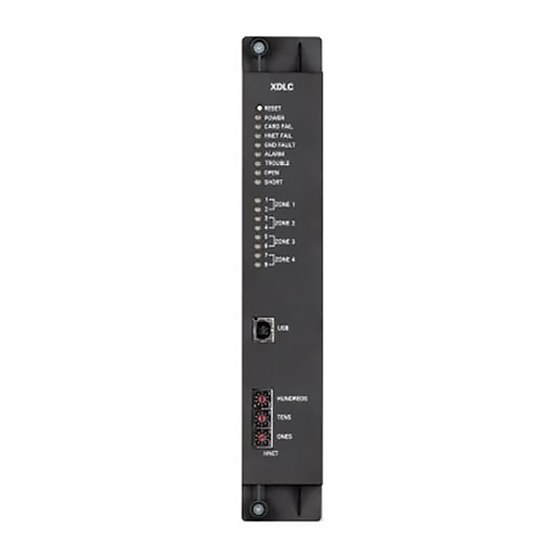
Advertisement
Installation Instructions
Model XDLC
Class X (DCLC) Device Loop Card
INTRODUCTION
OPERATION
A6V101040156_en--_c
The Model XDLC Device Loop Card from Siemens Industry,
Inc., is the interface for connection of Desigo Fire Safety
Modular/Cerberus PRO Modular smoke detectors, Multi-
Criteria detectors including Carbon Monoxide, manual
stations, monitor devices, and control devices to the Desigo
Fire Safety Modular/Cerberus PRO Modular System. The
XDLC uses one network address on the system. The
application program that is loaded into the on-board micro-
processor controls the XDLC operation.
The XDLC contains 16 LEDs for diagnosis of problems.
Ground fault detection is provided by the loop.
All field devices connected to the XDLC are addressed and
tested using the Device Programming Unit (DPU).
The XDLC initializes, operates, and maintains all devices
residing on the loop. The XDLC communicates all relevant
device and event information, such as alarms and troubles,
to the PMI-2/PMI-3/OI-C/OI-D (PMI). The sensitivity of any
intelligent smoke detector can be checked and adjusted
from the PMI through the XDLC. All information about the
devices on the loop can be displayed on the PMI. The XDLC
allows the System polarity insensitive devices to be
connected without generating errors.
NOTE: PMI = PMI-2/PMI-3/FCM2041
The XDLC supports four Class A (DCLA) or Class X (DCLC)
loops (eight Class B [DCLB] parallel lines/stubs) of up to
252 Desigo Fire Safety Modular/Cerberus PRO Modular
intelligent field devices as well as device accessories (relay
bases, audible bases, and remote lamps) in any combina-
tion. The microprocessor controls the on-board isolators to
isolate any zone from the loop if one of them is shorted.
When one zone is isolated from the loop, the other zones
will still work.
The on-board microprocessor provides the XDLC with the
ability to function and initiate alarm conditions even if the
main PMI CPU fails. The XDLC accomplishes this "degrade" mode of operation by
monitoring the communications with the PMI. In the case of the failure of the PMI,
XDLC
RESET
POWER
CARD FAIL
HNET FAIL
GND FAULT
ALARM
TROUBLE
OPEN
SHORT
1
2
3
4
5
6
7
8
HNET
Figure 1
XDLC Device Loop Card
Siemens
Siemens
Industry
Industry
Industry, , , , , Inc.
Siemens Industry
Siemens
Siemens
Industry
Building
Building
Building T T T T T ec
Building
Building
echnologies Di
ec
ec
ec
hnologies Di
hnologies Di
hnologies Di
hnologies Division
ZONE 1
ZONE 2
ZONE 3
ZONE 4
USB
HUNDREDS
TENS
ONES
Inc.
Inc.
Inc.
Inc.
vision
vision
vision
vision
Advertisement
Table of Contents

Summary of Contents for Siemens XDLC
- Page 1 The on-board microprocessor provides the XDLC with the ability to function and initiate alarm conditions even if the main PMI CPU fails. The XDLC accomplishes this “degrade” mode of operation by monitoring the communications with the PMI. In the case of the failure of the PMI,...
- Page 2 S527. Controls and Indicators The front panel of the XDLC contains one reset switch, 16 LEDs, and three HNET address switches, as shown in Figure 1. A reset switch is located on the top of the front panel. Pushing the reset switch re-initializes the XDLC operation.
- Page 3 Set the three-digit HNET network address for the XDLC using the three rotary dial switches located near the bottom of the front panel. (Refer to Figure 1 for the location of the switches.) The address for the XDLC must be the same as the HUNDREDS address selected for it in the Zeus Programming Tool.
- Page 4 Remove all system power before installation, first battery then AC. (To power up, connect the AC first, then the battery.) All field wiring to the XDLC is connected to the terminal blocks of the CC-5 card cage slot in which it is installed.
- Page 5 CLASS B WIRING*** T-TAPPING ALLOWED ZONE 1-1 ZONE 2-3 INITIATING DEVICE SHIELD (OPTIONAL) TERMINATE IN ENCLOSURE WITH THE XDLC. TERMINATE AT ONE END ONLY. TERMINATE TO EARTH GROUND. ZONE 1-2 ZONE 2-4 INITIATING DEVICE SHIELD (OPTIONAL) TERMINATE IN ENCLOSURE WITH THE XDLC. TERMINATE CLASS A or CLASS X WIRING** AT ONE END ONLY.
- Page 6 The XDLC circuit can be wired Class B (DCLB), Class A (DCLA), or Class X (DCLC). The configuration tool allows selection of Class A, X or B. The XDLC field circuit wiring does not require twisted, shielded wire, but is recommended. It can be installed in conduit containing low voltage power, notification appliance circuits, audible and speaker zone circuits, and RS-485 and other data circuits without restrictions.
- Page 7 ) I ( l a t t a l . e l t i r i t i t a l t i r i t i t a l Siemens Industry, Inc. A6V101040156_en--_c Building Technologies Division...
- Page 8 ) I ( t i r i t i t a l t i r i t i t a l ELECTRICAL RATINGS i l r Siemens Industry, Inc. A6V101040156_en--_c Building Technologies Division...
- Page 9 I = Isolator Device(s) (All wired for Isolator Mode) Return PANEL CLASS B XDLC P = Device(s) (Polarity Insensitive) No Devices used as Isolators Figure 6 Class X and B Device Loop Topologies Siemens Industry, Inc. A6V101040156_en--_c Building Technologies Division...
- Page 10 Cyber security disclaimer Siemens products and solutions provide security functions to ensure the secure operation of building comfort, fire safety, security management and physical security systems. The security functions on these products and solutions are important components of a comprehensive security concept.













